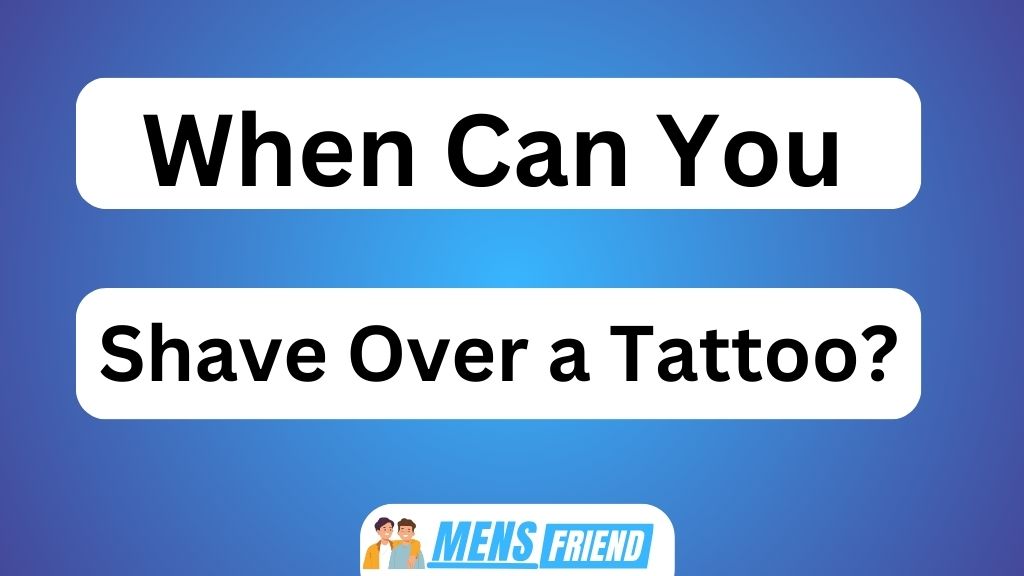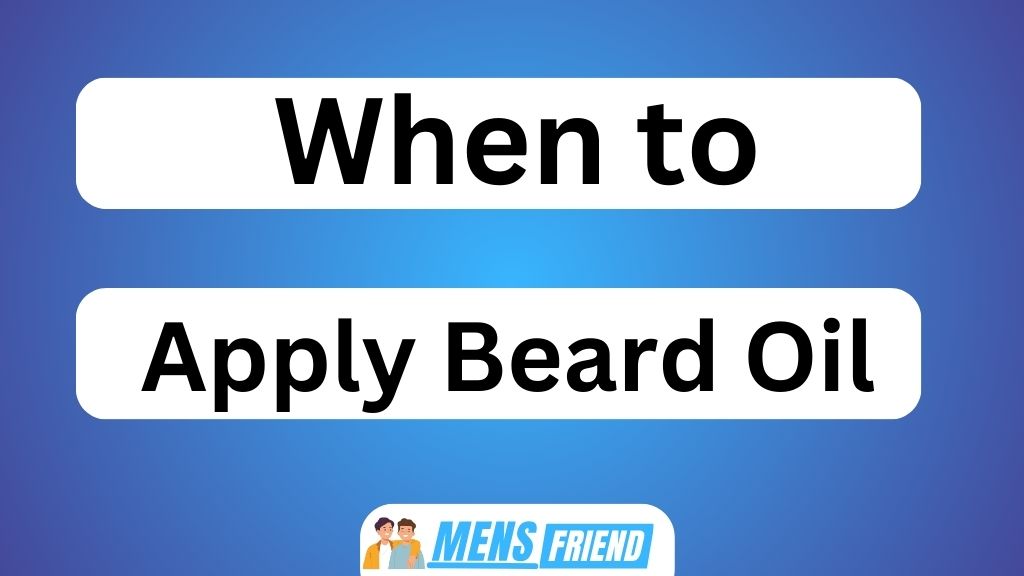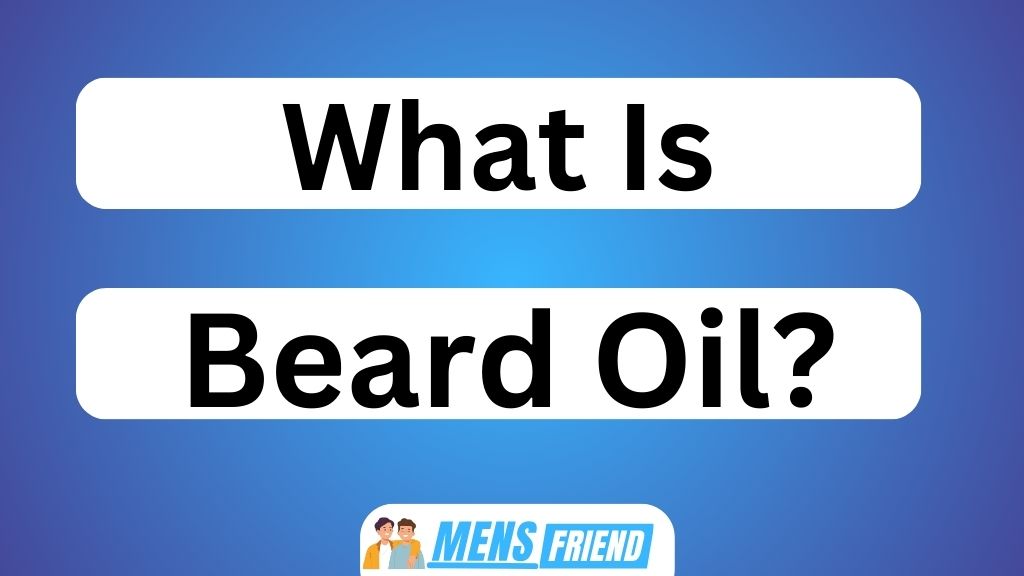We’ve all been there – eagerly waiting for our new tattoo to heal so we can finally shave over it and achieve that smooth, clean look.
But when is the right time? In this article, we’ll dive deep into the factors you need to consider before picking up that razor.
We’ll explore the healing process of a fresh tattoo and how long you should wait before shaving.
Plus, we’ll share essential tips on proper aftercare and precautions to take to ensure your tattoo stays pristine.
Get ready to master the art of shaving over a tattoo!
Key Takeaways When Can You Shave Over a Tattoo?
- Wait until your tattoo has fully healed before shaving over it (typically takes 2-3 weeks)
- Shaving directly on a fresh tattoo can irritate the skin and disrupt the healing process
- Factors like size, location, skin type, and aftercare practices can affect healing time
- Once the tattoo has fully healed, it’s safe to start using a razor for shaving
Factors to Consider Before Shaving Over a Tattoo
Before you shave over a tattoo, there are several factors you should consider.
Shaving precautions are crucial to ensure the safety and well-being of your tattooed skin.
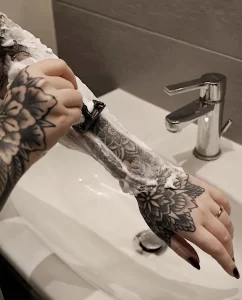
Firstly, it is essential to wait until your tattoo has fully healed before shaving over it. This typically takes around two to three weeks, depending on the size and location of the tattoo.
Secondly, always use a clean and sharp razor to minimize irritation or cuts on the delicate skin. Additionally, applying a thin layer of shaving cream or gel can provide lubrication and prevent any damage to the tattooed area.
Lastly, be gentle while shaving and avoid applying excessive pressure on the tattooed skin.
Following these tattoo aftercare techniques will help maintain the integrity of your ink while keeping your skin smooth and well-groomed.
The Healing Process of a Fresh Tattoo
During the healing process of a fresh tattoo, it’s important to avoid shaving directly on the tattooed area. Shaving can irritate the skin and disrupt the delicate process of healing, leading to potential complications such as infection or scarring.
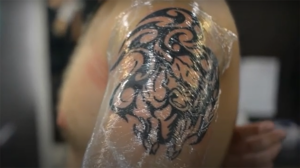
Moreover, shaving over a new tattoo can cause fading concerns as it may remove some of the ink or damage the surface of the skin where the tattoo is located.
To ensure proper tattoo preservation and minimize any risks during healing, it is recommended to wait until the tattoo has fully healed before resuming shaving in that area. This typically takes around two to four weeks, depending on individual healing times and aftercare practices.
It’s crucial to follow all aftercare instructions provided by your tattoo artist to promote optimal healing and preserve your new ink for years to come.
How Long Should You Wait Before Shaving a New Tattoo
When it comes to getting a new tattoo, there are several key points to consider for proper aftercare.
One important aspect is the healing time of the tattoo, as this will determine when it is safe to shave over it.
Additionally, understanding how to properly care for your tattoo after shaving is crucial for maintaining its quality and longevity.
Tattoo Healing Time
The tattoo usually takes about two to three weeks to fully heal. During this time, there are several factors that can affect the healing process. Factors such as the size and location of the tattoo, individual skin type, and aftercare practices can all influence how quickly a tattoo heals.
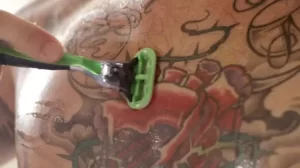
Proper care is crucial for optimal healing, including keeping the tattoo clean and moisturized, avoiding excessive sun exposure or soaking in water, and refraining from picking at scabs or scratching the area. Additionally, it’s important to wait until the tattoo is completely healed before shaving over it. Shaving too soon can disrupt the healing process and potentially lead to infection or damage to the tattooed skin. Once the tattoo has fully healed, proper shaving technique should be followed to avoid any irritation or damage to the artwork.
| Factors affecting Tattoo Healing Time | Proper Shaving Technique after Tattoo Healing |
|---|---|
| Size and location of tattoo | Wait until tattoo is fully healed |
| Individual skin type | Use a clean razor |
| Aftercare practices | Apply a gentle shaving cream |
| Sun exposure | Shave with light pressure |
| Avoiding picking at scabs | Moisturize after shaving |
Shaving After Tattoo
Once your tattoo has fully healed, it’s safe to start using a razor for shaving. However, there are some factors that can affect the color of your tattoo and common mistakes to avoid when shaving over it.
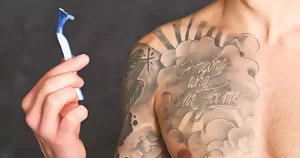
One important factor that can affect tattoo color is exposure to sunlight. UV rays can cause fading and discoloration, so it’s crucial to protect your tattoo with sunscreen or clothing when going outside. Another factor is the quality of ink used in your tattoo. High-quality inks tend to retain their vibrancy longer than cheaper alternatives.
When it comes to shaving, there are a few mistakes you should avoid. Firstly, be gentle and avoid applying too much pressure on the area around your tattoo. This can cause irritation and potentially damage the delicate skin. Secondly, make sure to use a clean razor blade to minimize the risk of infection.
Proper Tattoo Aftercare
Now that we have discussed shaving after getting a tattoo, let’s move on to the next important topic: proper tattoo aftercare. Taking care of your new tattoo is crucial in ensuring its longevity and preventing any complications.
One of the key precautions to take during this time is being mindful of shaving around the tattooed area. While it may be tempting to shave as usual, it’s essential to exercise caution to avoid irritating the freshly inked skin. The vibrations and pressure from razors can cause discomfort and even lead to post-tattoo irritation.
To minimize the risk, it is advisable to wait until the tattoo has fully healed before resuming regular shaving routines. During this healing period, follow your artist’s advice regarding cleaning and moisturizing the tattooed area, ensuring optimal healing conditions for your beautiful new artwork.
Understanding the Importance of Proper Tattoo Aftercare
To ensure proper healing of your tattoo, it’s crucial that you understand the importance of following the right aftercare routine. Proper tattoo care is essential not only for preserving the quality and longevity of your artwork but also for preventing infection.
After getting a tattoo, your skin undergoes a healing process that requires special attention and care. This includes keeping the tattoo clean and moisturized, avoiding direct sunlight or soaking in water, and refraining from picking or scratching at the scabs. By adhering to these guidelines, you can minimize the risk of infection and promote faster healing.
Additionally, it’s important to use products specifically designed for tattoo aftercare, such as gentle cleansers and fragrance-free moisturizers. Remember, taking proper care of your new ink will help ensure its beauty lasts a lifetime.
Can Shaving Affect the Tattoo Healing Process
When it comes to the tattoo healing process, shaving plays a crucial role in maintaining proper aftercare.
Firstly, it is essential to address how shaving can affect scab removal. Improper shaving techniques may lead to scabs being accidentally disturbed or removed prematurely, which can hinder the healing process and result in potential damage to the tattooed area.
Additionally, shaving can also contribute to irritation and redness if not done correctly or with gentle care.
Therefore, understanding proper aftercare techniques for shaving is vital for optimal tattoo healing and preservation.
Shaving and Scab Removal
It’s important to be gentle when shaving over a tattoo to avoid removing any scabs. Factors to consider when shaving with a healing tattoo include:
- Wait for the right time: It is crucial to wait until the scabs have fully healed before shaving over your tattoo.
- Use a clean razor: Always ensure that your razor is clean and free from bacteria or debris that could cause infection or irritation.
- Use minimal pressure: Apply light pressure while shaving to prevent any damage or irritation to the healing tattoo.
- Moisturize after shaving: After you’re done, make sure to moisturize the area with a fragrance-free lotion or ointment.
By following these guidelines, you can shave safely without compromising the healing process of your tattoo.
Now let’s delve into another aspect of post-tattoo care – irritation and redness.
Irritation and Redness
Using a fragrance-free lotion can help soothe and reduce irritation or redness around your healing tattoo. It is important to take proper care of your tattoo during the healing process to minimize skin irritation and prevent razor burn. When shaving over a healing tattoo, it is crucial to avoid causing any further damage or irritation. To help you understand how to prevent razor burn and minimize skin irritation, here is a table outlining some helpful tips:
| Tips for preventing razor burn and minimizing skin irritation | ||
|---|---|---|
| Use a clean, sharp razor | Shave in the direction of hair growth | Avoid applying too much pressure |
| Apply a thin layer of fragrance-free lotion before shaving | Rinse the area with cool water after shaving | Pat dry gently with a clean towel |
Proper Aftercare Techniques
To properly care for your healing tattoo, make sure to follow these aftercare techniques for optimal results.
- Keep it clean: Gently wash your tattoo with a mild, fragrance-free soap and lukewarm water twice a day. Pat it dry with a clean towel or let it air dry.
- Moisturize regularly: Apply a thin layer of unscented lotion or tattoo-specific ointment to keep the skin hydrated and prevent excessive dryness.
- Avoid picking or scratching: It’s crucial not to pick at any scabs or flakes that may form during the healing process. This can lead to infection and potential damage to the tattoo.
- Protect from sun exposure: Shield your healing tattoo from direct sunlight by wearing loose clothing or using sunscreen with high SPF whenever you’re outside. UV rays can fade the colors and hinder the healing process.
Tips for Shaving Around a Healed Tattoo
When shaving around a healed tattoo, make sure to use a clean and sharp razor for the best results. This will help prevent ingrown hairs and reduce razor burn, which can be irritating to the skin and potentially damage your tattoo. Along with using a good quality razor, there are some additional tips you can follow to ensure a smooth shave without compromising the integrity of your tattoo.
Firstly, always make sure to moisturize the area before shaving. This helps soften the hair and prepares the skin for a closer shave. Additionally, shave in the direction of hair growth to avoid irritation and cuts. Lastly, remember to rinse the blade frequently during shaving to remove any buildup of hair or product.
Here is a table summarizing these tips:
| Tips for Shaving Around a Healed Tattoo |
|---|
| Use a clean and sharp razor |
| Moisturize before shaving |
| Shave in the direction of hair growth |
| Rinse blade frequently |
Precautions to Take When Shaving Over a Tattoo
When it comes to shaving, it’s important to practice proper technique to ensure a smooth and irritation-free shave.
We’ve learned that using a sharp razor, applying gentle pressure, and moving in the direction of hair growth can help prevent cuts and nicks.
Additionally, taking precautions such as cleansing the skin before shaving and moisturizing afterwards can help avoid irritation and infection.
Proper Shaving Technique
Make sure you’re using a sharp razor and applying gentle pressure when shaving over your tattoo. Proper shaving technique is crucial to prevent any damage or irritation to the newly inked skin. Here are some tips to ensure a smooth and safe shave:
- Use proper shaving equipment: Invest in a high-quality razor with a fresh blade to minimize the risk of nicks and cuts. Disposable razors may cause more friction, leading to razor burn.
- Prepare the area: Before shaving, clean your tattoo with mild soap and warm water. This will help remove any excess dirt or oils that could clog the razor blades.
- Shave in the direction of hair growth: Shaving against the grain can cause irritation and ingrown hairs, so be sure to follow the natural direction of hair growth.
- Moisturize afterward: After shaving, apply a fragrance-free moisturizer to keep your skin hydrated and prevent dryness.
Avoiding Irritation and Infection
To prevent irritation and infection, it’s important to properly clean and moisturize your tattooed skin after shaving.
Shaving can potentially cause razor burn and lead to ingrown hairs, which can be particularly troublesome on tattooed skin. Our experience has taught us that following a few simple steps can help avoid these issues.
Firstly, cleanse the skin gently with a mild soap or cleanser to remove any bacteria or dirt that may have accumulated during the shaving process.
Next, apply a soothing moisturizer that is specifically formulated for sensitive skin to keep the area hydrated and nourished. This will promote healing and reduce the likelihood of irritation.
Lastly, remember to shave in the direction of hair growth, using a sharp blade to minimize friction and prevent ingrown hairs from forming.
What Tools and Products to Use for Shaving Over a Tattoo
You’ll want to use a clean, sharp razor and a gentle shaving cream when you shave over a tattoo. Taking proper care of your tattoo during the healing process is crucial, and using the right tools and products can help prevent irritation and maintain the vibrancy of your ink.
Here are four essential tattoo shaving tools and pre-shave products:
- Cleanse: Start by cleansing the skin around your tattoo with a mild, fragrance-free soap to remove any dirt or bacteria.
- Exfoliate: Gently exfoliate the area using a soft brush or sponge to remove dead skin cells and promote smoothness.
- Shaving Cream: Apply a thin layer of shaving cream specifically designed for sensitive skin to protect your tattoo from nicks, cuts, and irritation.
- Sharp Razor: Use a fresh blade on your razor to ensure a close shave without pulling or tugging on the delicate skin.
Shaving Techniques to Avoid Damaging Your Tattoo
Now that we know about the right tools and products to use for shaving over a tattoo, it’s important to understand the shaving techniques that can help us avoid damaging our beloved ink.
When shaving over a tattoo, it’s crucial to be gentle and take extra precautions to preserve the integrity of the design. Applying too much pressure or using harsh strokes can lead to tattoo fading or even cause irritation and ingrown hairs.
To prevent these issues, always shave in the direction of hair growth and avoid going against the grain. This will minimize the risk of irritating the skin and causing damage to your tattoo. Additionally, make sure to use a clean razor blade each time you shave as dull blades can tug on your skin and potentially harm your tattoo.
Transitioning into how to maintain your tattoo after shaving…
How to Maintain Your Tattoo After Shaving
After shaving, it’s important to moisturize your tattoo regularly to keep the skin hydrated and enhance the vibrancy of the ink. Proper tattoo maintenance is crucial for ensuring its longevity and preserving its appearance. Here are four essential post-shaving care tips:
- Cleanse gently: Use a mild, fragrance-free soap or cleanser to wash your tattooed area after shaving. Avoid harsh scrubbing or rubbing that can irritate the skin.
- Pat dry: After cleansing, gently pat your tattoo dry with a clean towel or let it air dry naturally. Avoid rubbing as it can cause unnecessary friction and irritation.
- Apply moisturizer: Choose a non-scented, water-based moisturizer specifically formulated for tattoos. Apply a thin layer over your tattooed area to prevent dryness and maintain its vibrant colors.
- Protect from sun exposure: Sunlight can fade tattoos and damage the skin, so always protect your tattooed area with sunscreen (SPF 30 or higher) when going outside.
Frequently Asked Questions
Can You Shave Over a Tattoo Immediately After Getting It?
We know the importance of proper shaving precautions and techniques. It’s essential to consider the healing process of a tattoo before shaving over it immediately. Consult with a professional for personalized advice.
Will Shaving Over a Fresh Tattoo Cause Infection or Hinder the Healing Process?
Shaving over a fresh tattoo can increase the risk of infection and hinder the healing process. However, with proper tattoo hygiene, such as using a clean razor and following aftercare instructions, shaving can be done safely.
Are There Any Specific Aftercare Products or Tools to Use When Shaving Over a Tattoo?
When it comes to tattoo shaving tips, using the best shaving cream for tattoos is essential. It helps to prevent irritation and maintain the integrity of the tattoo. Proper aftercare products and tools are crucial for a successful healing process.
Can Shaving Over a Tattoo Fade or Damage the Tattoo Design?
Shaving over a tattoo requires careful precautions to minimize the risk of fading or damaging the design. We know from experience that improper shaving techniques can lead to unwanted consequences, so it’s important to proceed with caution.
How Often Should You Shave Over a Tattoo to Maintain Its Appearance and Keep It Looking Fresh?
We recommend shaving over a tattoo regularly to maintain its appearance and keep it looking fresh. However, be cautious as razor burn and ingrown hairs can potentially damage the tattoo design.
Conclusion
In conclusion, it’s crucial to exercise caution and patience when shaving over a tattoo. The healing process of a fresh tattoo should not be rushed, as it can take several weeks for the skin to fully heal. Proper aftercare is essential in maintaining the vibrancy and longevity of your tattoo.
Remember, just like nurturing a delicate flower, caring for your tattoo requires diligence and gentle handling. So take the time to pamper your inked masterpiece, and it will continue to shine brightly for years to come.

